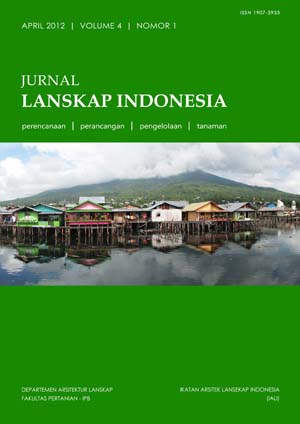PERENCANAAN LANSKAP SUNGAI KELAYAN SEBAGAI UPAYA REVITALISASI SUNGAIDI KOTA BANJARMASIN KALIMANTAN SELATAN
Abstract
Kelayan River is a small river in Banjarmasin City. Urbanization in the city has caused the physical development expansion up to the river bank and its impact has decreased the biophysical quality of the area. The objectives of this study are to identitylandscape potencies and problems in Kelayan River area; to analize biophysical, social, cultural and economical aspect of Kelayan River which will influence the river landscape planning based on biophysical aspect tosupport Kelayan River revitalization; which able to reflect waterfront city. Method of the study following the landscape planning process of Simonds (1983)consisted of preparation, collecting data, analysis, synthesis, and planning. This study uses biophysical approach modified from Astuti and Fandeli (2009). Biophysical aspects to be considered are rain fall, land coverage (Land Coverage Index IPL), inundated area, land use (Land Use Suitability/KPL), vegetation and fauna. In analysis phase, the river is divided to seven segments based on administrative boundary. Each aspect will be analized quantitatively using scoring and weighting, as well as spatially. The analysis results
biophysical quality classification i.e. very critical, critical, moderate, and good quality. The synthesis is directed to improve biophysical condition and to accommodate proposed land use through rehabilitation and conservation. The good biophysical quality segment is allocated to non-intensive rehabilitation zone, while the moderate biophysical quality segment is developed tosemi-intensive rehabilitation zone, and the critical and very critical segments are used for intensive rehabilitation zone and will be utilized for non-conservation area. Functional river with good quality of biophysical condition and reflecting waterfront city is the concept in the landscape
plan for this area. The plan divides the area into three zones which are: (1) Non-intensive Rehabilitation Zone (16%), (2) Semi-intensive Rehabilitation Zone (33%), and Intensive Rehabilitation Zone (51%). The landscape plan is developed to spatial, circulation, vegetation, and settlement plans.
Downloads
This journal permits and encourages authors to post items submitted to the journal on personal websites or institutional repositories both prior to and after publication, while providing bibliographic details that credit, if applicable, its publication in this journal. However, after the article is submitted and published in this journal, it is fully copyrighted by the Jurnal Lanskap Indonesia or JLI. If excerpts from other copyrighted works are included, the author must obtain written permission from the copyright owner and give credit to the source in the article. Then, the writer or reader is allowed to copy, share, and redistribute articles/material in any form. But it must still include the appropriate source and credit because the article in this journal is licensed by Creative Commons Attribution 4.0 International License (CC BY 4.0).
I. Proposed Policy for Journals That Offer Open Access
Authors who publish with this journal agree to the following terms:
- Authors retain copyright and grant the journal right of first publication with the work simultaneously licensed under a Creative Commons Attribution License that allows others to share the work with an acknowledgement of the work's authorship and initial publication in this journal.
- Authors are able to enter into separate, additional contractual arrangements for the non-exclusive distribution of the journal's published version of the work (e.g., post it to an institutional repository or publish it in a book), with an acknowledgement of its initial publication in this journal.
- Authors are permitted and encouraged to post their work online (e.g., in institutional repositories or on their website) prior to and during the submission process, as it can lead to productive exchanges, as well as earlier and greater citation of published work (See The Effect of Open Access).
II. Proposed Policy for Journals That Offer Delayed Open Access
Authors who publish with this journal agree to the following terms:
- Authors retain copyright and grant the journal right of first publication, with the work after publication simultaneously licensed under a Creative Commons Attribution License that allows others to share the work with an acknowledgement of the work's authorship and initial publication in this journal.
- Authors are able to enter into separate, additional contractual arrangements for the non-exclusive distribution of the journal's published version of the work (e.g., post it to an institutional repository or publish it in a book), with an acknowledgement of its initial publication in this journal.
- Authors are permitted and encouraged to post their work online (e.g., in institutional repositories or on their website) prior to and during the submission process, as it can lead to productive exchanges, as well as earlier and greater citation of published work (See The Effect of Open Access).



























